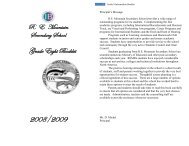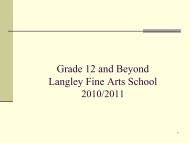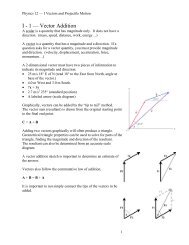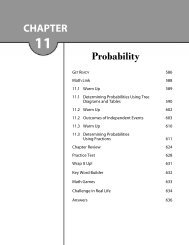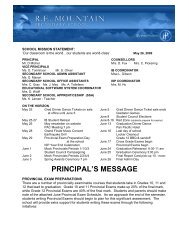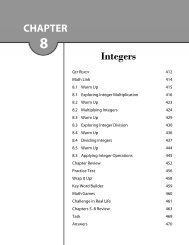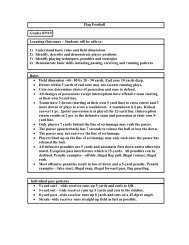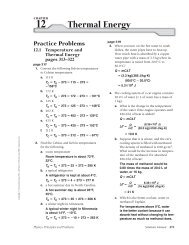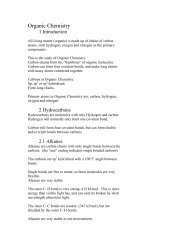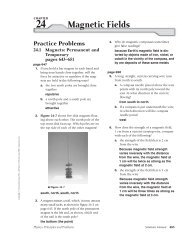CHAPTER Surface Area - School District #35
CHAPTER Surface Area - School District #35
CHAPTER Surface Area - School District #35
- No tags were found...
You also want an ePaper? Increase the reach of your titles
YUMPU automatically turns print PDFs into web optimized ePapers that Google loves.
<strong>CHAPTER</strong><br />
5<br />
<strong>Surface</strong> <strong>Area</strong><br />
GET READY 226<br />
Math Link 228<br />
5.1 Warm Up 229<br />
5.1 Views of Three-Dimensional Objects 230<br />
5.2 Warm Up 238<br />
5.2 Nets of Three-Dimensional Objects 239<br />
5.3 Warm Up 245<br />
5.3 <strong>Surface</strong> <strong>Area</strong> of a Prism 246<br />
5.4 Warm Up 255<br />
5.4 <strong>Surface</strong> <strong>Area</strong> of a Cylinder 256<br />
Chapter Review 267<br />
Practice Test 272<br />
Wrap It Up! 274<br />
Key Word Builder 276<br />
Math Games 277<br />
Challenge in Real Life 278<br />
Answers 280
Name: _____________________________________________________<br />
Date: ______________<br />
Three-Dimensional Objects<br />
3-dimensional (3-D)<br />
● an object that has length,<br />
width, and height<br />
● you can describe a<br />
3-D object by its faces,<br />
edges, and vertices<br />
face–flat or<br />
curved surface<br />
edge–line segment where 2 faces meet<br />
vertex–point where 3<br />
or more edges meet<br />
1. Write the name and the number of edges, faces, and vertices for each object.<br />
Object Name Faces Edges Vertices<br />
Circles<br />
radius<br />
● the distance from the centre of the circle to the outside edge<br />
● r shows the radius<br />
● the radius is half the diameter: r = d ÷ 2 or r = d<br />
2<br />
diameter<br />
● the distance across a circle through its centre<br />
● d shows the diameter<br />
● the diameter is twice the radius: d = 2 × r or<br />
circumference<br />
● the distance around a circle (the perimeter)<br />
● C shows the circumference<br />
● C = 2 × π × r or C = π × d<br />
area<br />
d = 2r<br />
π is about 3.14<br />
● the number of square units needed to cover a 2-dimensional shape<br />
● A shows the area<br />
r 2 means r × r<br />
● A = π × r 2 2<br />
or A = πr<br />
C<br />
d<br />
r<br />
226 MHR ● Chapter 5: <strong>Surface</strong> <strong>Area</strong>
Name: _____________________________________________________<br />
Date: ______________<br />
2. Find the circumference of each circle to the nearest tenth (1 decimal place).<br />
a)<br />
6 cm<br />
b)<br />
2 cm<br />
C = π × d<br />
C = 2 × π × r<br />
= 3.14 ×<br />
= 2 × ×<br />
= cm<br />
=<br />
3. Find the area of each circle to the nearest tenth (1 decimal place).<br />
a)<br />
2 cm<br />
A = π × r 2<br />
A = π × r × r<br />
b)<br />
= × ×<br />
5 cm<br />
<strong>Area</strong> Formulas<br />
h<br />
w<br />
<strong>Area</strong> of a rectangle = l × w<br />
l<br />
<strong>Area</strong> of a triangle = b × h ÷ 2<br />
b<br />
b<br />
<strong>Area</strong> of a parallelogram = b × h<br />
h<br />
4. Find the area of each shape.<br />
<strong>Area</strong> is measured<br />
in square units.<br />
a)<br />
6 cm<br />
b)<br />
h = 5.5 cm<br />
9 cm<br />
b = 10 cm<br />
A = b × h ÷ 2<br />
= × ÷ 2<br />
A = b × h<br />
= ×<br />
=<br />
=<br />
Get Ready ● MHR 227
Name: _____________________________________________________<br />
Date: ______________<br />
City Planning<br />
When city planners design communities, they<br />
think about many things, such as:<br />
● types of buildings<br />
● width of streets<br />
● where to put bus stops<br />
Imagine you are a city planner for a miniature community.<br />
miniature<br />
● a small version of something<br />
1. A community needs different buildings. For example, food stores, banks, and hospitals are often<br />
on the main street of a community.<br />
Use the table to organize information about the buildings a community needs.<br />
Type of Building<br />
Where the Building Is<br />
Located in the Community<br />
Shapes of Its Faces<br />
Bank main street square, rectangle<br />
Discuss your answers to #1 with a partner. Then, share your ideas with the class.<br />
2. What else does a community need (e.g., streets, fire hydrants, and telephone wires)<br />
_____________________________________________________________________________<br />
_____________________________________________________________________________<br />
3. Imagine you are in an airplane. Using grid paper, sketch part of<br />
an aerial view of a community. Draw the buildings, roads,<br />
and any other features from #2 that are important.<br />
Aerial means from<br />
the air or from above.<br />
228 MHR ● Chapter 5: <strong>Surface</strong> <strong>Area</strong>
Name: _____________________________________________________<br />
Date: ______________<br />
5.1 Warm Up<br />
1. Draw a square and a rectangle.<br />
a) square b) rectangle<br />
1<br />
2<br />
2. Use isometric dot paper to make it easier to draw 3-D shapes.<br />
Follow the steps to draw each solid.<br />
3 4<br />
a) cube b) rectangular prism<br />
3. Draw the top, front, and side view of your cube and rectangular prism.<br />
a) cube b) rectangular prism<br />
top front side top front side<br />
4. Circle the diagram that shows a 90° clockwise rotation.<br />
a) b)<br />
5.1 Warm Up ● MHR 229
Name: _____________________________________________________<br />
Date: ______________<br />
5.1 Views of Three-Dimensional Objects<br />
A 3-D object has length,<br />
width, and height.<br />
Working Example 1: Draw and Label Top, Front, and Side Views<br />
Draw the top, front, and side view of each item.<br />
Label each view.<br />
a) Tissue box<br />
Solution<br />
top<br />
front<br />
side<br />
(end of the box)<br />
b) Compact disc case<br />
Solution<br />
top<br />
Draw the top, front, and side views of this object.<br />
top front side<br />
230 MHR ● Chapter 5: <strong>Surface</strong> <strong>Area</strong>
Name: _____________________________________________________<br />
Date: ______________<br />
Working Example 2: Sketch a Three-Dimensional Object When Given Views<br />
An object made of 6 blocks has these views.<br />
Sketch the object.<br />
top<br />
front side<br />
Solution<br />
Sketch the object on isometric paper.<br />
Draw the same object on the grid.<br />
An object is made using 5 blocks.<br />
The top, front, and side views are shown.<br />
top<br />
front<br />
side<br />
Sketch the object on isometric dot paper.<br />
5.1 Views of Three-Dimensional Objects ● MHR 231
Name: _____________________________________________________<br />
Date: ______________<br />
Working Example 3: Predict and Draw the Top, Front, and<br />
Side Views After a Rotation<br />
The diagrams show the top, front, and side views of a computer tower.<br />
top front side<br />
Rotate the computer tower 90° clockwise on its base.<br />
top<br />
90°<br />
a) Which view will become the new front view after the rotation<br />
Solution<br />
The side view will become the new front view after rotation.<br />
b) Label the top, front, and side views after rotating the tower.<br />
Solution<br />
232 MHR ● Chapter 5: <strong>Surface</strong> <strong>Area</strong>
Name: _____________________________________________________<br />
Date: ______________<br />
Stand a book on your desk.<br />
a) Draw the top, front, and side views.<br />
b) Rotate the book 90° clockwise around its spine.<br />
What will the top, front, and side views look like<br />
The<br />
position after the rotation.<br />
The<br />
view after the rotation.<br />
The<br />
view after the rotation.<br />
view will only change its<br />
view will become the side<br />
view will become the front<br />
spine<br />
c) Draw the top, front, and side views after rotating the book.<br />
top front side<br />
5.1 Views of Three-Dimensional Objects ● MHR 233
Name: _____________________________________________________<br />
Date: ______________<br />
1.<br />
front<br />
top side<br />
Are these views of a book correct Circle YES or NO.<br />
Give 1 reason for your answer.<br />
________________________________________________________________________________<br />
________________________________________________________________________________<br />
2. Draw and label the top, front, and side views.<br />
a) b)<br />
top front side top front side<br />
234 MHR ● Chapter 5: <strong>Surface</strong> <strong>Area</strong>
Name: _____________________________________________________<br />
Date: ______________<br />
3.<br />
A<br />
B<br />
C<br />
D<br />
E<br />
F<br />
G<br />
a) Circle the top view.<br />
b) Put a square around the front view.<br />
c) Put an X on the side view.<br />
4. Draw each 3-D object using the views.<br />
a)<br />
top front side<br />
b) top front side<br />
5. A microwave has these views.<br />
top front side<br />
Turn the microwave 90° counterclockwise.<br />
Draw each new view.<br />
top front side<br />
5.1 Views of Three-Dimensional Objects ● MHR 235
Name: _____________________________________________________<br />
Date: ______________<br />
6. Choose two 3-D objects from your classroom.<br />
Draw the top, front, and side views for each.<br />
Object 1:<br />
top front side<br />
Object 2:<br />
top front side<br />
7. Draw the top, front, and side views for each.<br />
a)<br />
You can make the<br />
shapes out of blocks<br />
before you draw them.<br />
top front side<br />
b)<br />
top front side<br />
236 MHR ● Chapter 5: <strong>Surface</strong> <strong>Area</strong>
Name: _____________________________________________________<br />
Date: ______________<br />
a) Choose 1 of the important buildings from your community in the Math Link on page 228.<br />
Name of building: _________________________________________________________<br />
Sketch a 3-D view of the building.<br />
b) Draw and label the top, front, and side views.<br />
top front side<br />
5.1 Math Link ● MHR 237
Name: _____________________________________________________<br />
Date: ______________<br />
5.2 Warm Up<br />
1. Draw the top, front, and side views of each solid.<br />
a) b)<br />
top front side top front side<br />
2. Measure the length, width, and height of each solid.<br />
a) b)<br />
length =<br />
width =<br />
height =<br />
cm<br />
length =<br />
width =<br />
height =<br />
3. Each side of each solid is a 2-D shape.<br />
Name the shapes in each solid.<br />
a) b)<br />
c) d)<br />
238 MHR ● Chapter 5: <strong>Surface</strong> <strong>Area</strong>
Name: _____________________________________________________<br />
5.2 Nets of Three-Dimensional Objects<br />
base of prism<br />
• a face that shows the shape of the prism<br />
Date: ______________<br />
A prism is a 3-D<br />
figure.<br />
rectangular prism<br />
• a prism with bases that are congruent rectangles<br />
Congruent means<br />
having the same size<br />
and shape.<br />
right prism<br />
• a prism with sides that are perpendicular ( ⊥)<br />
to the bases<br />
net<br />
• a 2-dimensional shape that, when folded, creates a 3-D object<br />
net<br />
cube<br />
Working Example 1: Draw a Net for a Three-Dimensional Object<br />
Draw a net for the umbrella stand.<br />
Solution<br />
Think, “What would the umbrella stand look like if you could cut it open and flatten it”<br />
The net has 1<br />
and 1 rectangle.<br />
The width of the rectangle is equal to the distance around the circle, which is called the<br />
.<br />
Draw a net for an unopened soup can.<br />
SOUP<br />
5.2 Nets of Three-Dimensional Objects ● MHR 239
Name: _____________________________________________________<br />
Date: ______________<br />
Working Example 2: Build a Three-Dimensional Object From a Given Net<br />
triangular prism<br />
• a prism with 2 triangular bases<br />
• each base is the same size and shape<br />
• the sides are rectangles<br />
Can this net be folded to form a tent<br />
Solution<br />
Trace the net on a sheet of paper.<br />
Cut along the outside edges.<br />
Fold along the inside edges.<br />
Tape the edges together to build a triangular prism.<br />
Build a 3-D object from this net.<br />
What object does it make<br />
240 MHR ● Chapter 5: <strong>Surface</strong> <strong>Area</strong>
Name: _____________________________________________________<br />
Date: ______________<br />
1. Both of these nets have 6 faces.<br />
Net A Net B<br />
Will both nets form a cube<br />
Explain your answer.<br />
Draw the nets on grid paper. Cut them<br />
out. Try to make each 1 into a cube.<br />
______________________________________________________________________________<br />
______________________________________________________________________________<br />
______________________________________________________________________________<br />
2. Sketch a net for each object.<br />
a)<br />
b)<br />
hockey puck<br />
chocolate bar<br />
5.2 Nets of Three-Dimensional Objects ● MHR 241
Name: _____________________________________________________<br />
Date: ______________<br />
3. Draw the net for each object.<br />
Label the measurements on the net.<br />
a) d = 30 mm<br />
b)<br />
78 mm<br />
28 cm<br />
Paper<br />
500 Sheets<br />
21.5 cm<br />
5 cm<br />
4. a) Trace this net on grid paper.<br />
Cut along the outside edges of the net.<br />
Fold on the dotted lines to form a 3-D<br />
object.<br />
b) What is this object called<br />
5. Match each solid with its net.<br />
Write your answers on the blanks.<br />
Some solids are used more than once.<br />
Copy the nets on grid paper.<br />
Then, try to make the 3-D object.<br />
rectangular prism<br />
cylinder<br />
triangular prism<br />
242 MHR ● Chapter 5: <strong>Surface</strong> <strong>Area</strong>
Name: _____________________________________________________<br />
Date: ______________<br />
6. A box measures 6 cm × 1 cm × 2 cm.<br />
Draw a net for the box on the grid.<br />
6 cm<br />
2 cm<br />
1 cm<br />
7. You are designing a cookie jar.<br />
Draw a net for your cookie jar.<br />
Include all the measurements.<br />
8. Many possible nets can make a cube. Here is 1 possible net.<br />
Draw 2 other possible nets.<br />
Net 1 Net 2<br />
5.2 Nets of Three-Dimensional Objects ● MHR 243
Name: _____________________________________________________<br />
Date: ______________<br />
a) Draw two 3-D sketches of buildings for your miniature community:<br />
• a prism-shaped building<br />
• a cylinder-shaped building<br />
Name of building:<br />
Name of building:<br />
b) Draw nets of the 2 buildings. Label all the measurements on the nets.<br />
244 MHR ● Chapter 5: <strong>Surface</strong> <strong>Area</strong>
Name: _____________________________________________________<br />
Date: ______________<br />
5.3 Warm Up<br />
1. Draw each rectangle.<br />
a) length 3 cm, width 2.5 cm b) length 43 mm, width 17 mm<br />
2. Find the area of each rectangle.<br />
a)<br />
8 cm<br />
b)<br />
3.4 m<br />
1.1 m<br />
9.1 cm<br />
A=<br />
l×<br />
w<br />
= 9.1×<br />
8<br />
= ______________ cm<br />
2<br />
3. Find the area of each triangle.<br />
a)<br />
h = 14 m<br />
b)<br />
b = 6 cm<br />
h = 2.2 cm<br />
b = 10 m<br />
A = (b × h) ÷ 2<br />
← Formula →<br />
A = (b × h) ÷ 2<br />
= (10 × 14) ÷ 2 ← Substitute →<br />
= ÷ 2<br />
= m 2 ← Answer →<br />
= ( × ) ÷ 2<br />
= ÷ 2<br />
= cm 2<br />
4. Find the answer.<br />
a) 5 × 7 = b) 9 × 4 =<br />
c) 24 ÷ 6 = d) 30 ÷ 10 =<br />
e) 24 ÷ 2 = f) 40 ÷ 2 =<br />
5.3 Warm Up ● MHR 245
Name: _____________________________________________________<br />
Date: ______________<br />
5.3 <strong>Surface</strong> <strong>Area</strong> of a Prism<br />
surface area<br />
• the number of square units needed to cover all the faces of<br />
a 3-D object<br />
• the sum of the areas of all the faces of an object<br />
• measured in square units (cm 2 , m 2 )<br />
Working Example 1: Calculate the <strong>Surface</strong> <strong>Area</strong> of a Right Rectangular Prism<br />
a) Draw the net of this right rectangular prism.<br />
Solution<br />
4 cm<br />
10 cm<br />
10 cm<br />
6 cm<br />
front or back<br />
top or bottom<br />
6 cm<br />
4 cm<br />
10 cm<br />
10 cm<br />
= 10 ×<br />
= cm 2<br />
<strong>Area</strong> of top and bottom<br />
= 40 × 2<br />
= cm 2<br />
b) What is the surface area of the prism<br />
Solution<br />
The right rectangular prism has 6 faces. There are 3 different sizes of faces.<br />
A = l × w<br />
= 10 × 6<br />
=<br />
<strong>Area</strong> of front<br />
= 60 × 2<br />
=<br />
cm 2<br />
back<br />
cm 2 A = l × w<br />
= cm 2 A = l × w<br />
= 6 ×<br />
=<br />
<strong>Area</strong> of<br />
= 24 × 2<br />
=<br />
cm 2<br />
sides<br />
cm 2<br />
and both<br />
<strong>Surface</strong> <strong>Area</strong> = (area of front and back) + (area of top and bottom) + (area of ends)<br />
= 120 + 80 + 48<br />
6 cm<br />
4 cm<br />
4 cm<br />
ends<br />
6 cm<br />
246 MHR ● Chapter 5: <strong>Surface</strong> <strong>Area</strong>
Name: _____________________________________________________<br />
Date: ______________<br />
What is the surface area of the right rectangular prism<br />
16 cm<br />
8 cm<br />
3 cm<br />
front or back<br />
cm<br />
top or bottom<br />
cm<br />
cm<br />
cm<br />
ends<br />
cm<br />
cm<br />
A = l × w<br />
= ×<br />
=<br />
A = l × w<br />
= ×<br />
=<br />
A = l × w<br />
= ×<br />
=<br />
<strong>Area</strong> of front and back:<br />
A = × 2<br />
=<br />
<strong>Area</strong> of top and bottom:<br />
A = × 2<br />
=<br />
<strong>Area</strong> of 2 ends:<br />
A = ×<br />
=<br />
<strong>Surface</strong> <strong>Area</strong> = (area of front and back) + (area of top and bottom) + (area of ends)<br />
= + +<br />
= cm 2<br />
The surface area of the right rectangular prism is cm 2 .<br />
5.3 <strong>Surface</strong> <strong>Area</strong> of a Prism ● MHR 247
Name: _____________________________________________________<br />
Date: ______________<br />
Working Example 2: Calculate the <strong>Surface</strong> <strong>Area</strong> of a Right Triangular Prism<br />
a) Draw the net of this right triangular prism.<br />
Solution<br />
9 m<br />
9 m<br />
3 m<br />
2.6 m<br />
3 m<br />
2.6 m<br />
b) What is the surface area<br />
3 sides with the same length<br />
Solution<br />
The bases of the prism are equilateral triangles. The sides of the prism are rectangles.<br />
rectangle<br />
triangle<br />
3 m<br />
2.6 m<br />
9 m<br />
A = l × w<br />
A = (b × h) ÷ 2<br />
= m 2<br />
= 9 ×<br />
= (3 × 2.6) ÷ 2<br />
3 m<br />
= ÷ 2<br />
= m 2<br />
The right triangular prism has 5 faces.<br />
A =<br />
A =<br />
A =<br />
A =<br />
A =<br />
<strong>Surface</strong> <strong>Area</strong> = (3 × area of rectangle) + (2 × area of triangle)<br />
= (3 × 27) + (2 × 3.9)<br />
= +<br />
248 MHR ● Chapter 5: <strong>Surface</strong> <strong>Area</strong><br />
=<br />
The surface area of the right triangular prism is m 2 .
Name: _____________________________________________________<br />
Date: ______________<br />
Find the surface area of the right triangular prism.<br />
How many different-sized rectangles are there<br />
7 cm<br />
9.9 cm<br />
7 cm<br />
2 cm<br />
small rectangle<br />
7 cm<br />
______ cm<br />
A = l × w<br />
=<br />
9.9 cm<br />
_______ cm<br />
= cm 2 large rectangle<br />
A = l × w<br />
=<br />
= cm 2<br />
How many triangles of the same size are there<br />
cm<br />
A = (b × h) ÷ 2<br />
= ( × ) ÷ 2<br />
cm<br />
= ÷ 2<br />
= cm 2<br />
<strong>Surface</strong> <strong>Area</strong> = (2 × area of small rectangles) + (area of large rectangle) + (2 × area of triangle)<br />
= (2 × ) + + (2 × )<br />
= + + ( )<br />
=<br />
The surface area of the right triangular prism is cm 2 .<br />
5.3 <strong>Surface</strong> <strong>Area</strong> of a Prism ● MHR 249
Name: _____________________________________________________<br />
Date: ______________<br />
1. Write the steps that you could use to find the surface area of a prism.<br />
2. Find the surface area of the rectangular prism to the nearest tenth of a<br />
square centimetre (1 decimal place).<br />
front or back<br />
top or bottom<br />
18 cm<br />
ends<br />
10 cm<br />
5.5 cm<br />
cm<br />
cm<br />
cm<br />
cm<br />
cm<br />
cm<br />
A = l × w<br />
= ×<br />
=<br />
<strong>Area</strong> of front and back:<br />
A = × 2<br />
=<br />
A = l × w<br />
= ×<br />
=<br />
<strong>Area</strong> of top and bottom:<br />
A = × 2<br />
=<br />
A = ×<br />
= ×<br />
=<br />
<strong>Area</strong> of 2 ends:<br />
A = ×<br />
=<br />
<strong>Surface</strong> <strong>Area</strong> = (area of front and back) + (area of top and bottom) + (area of ends)<br />
= + +<br />
= cm 2<br />
The surface area of the right rectangular prism is cm 2 .<br />
250 MHR ● Chapter 5: <strong>Surface</strong> <strong>Area</strong>
Name: _____________________________________________________<br />
Date: ______________<br />
3. Find the surface area of this ramp in the shape of a right triangular prism.<br />
3 m<br />
5 m<br />
4 m<br />
0.7 m<br />
ramp rectangle<br />
bottom rectangle<br />
end rectangle<br />
0.7 m<br />
5 m<br />
0.7 m<br />
4 m<br />
0.7 m<br />
3 m<br />
A = l × w<br />
= ×<br />
= m 2<br />
triangle<br />
m<br />
A = (b × h) ÷ 2<br />
= ( × ) ÷ 2<br />
= ÷ 2<br />
m<br />
= m 2<br />
<strong>Surface</strong> <strong>Area</strong> = (area of 3 rectangles) + (2 × area of triangle)<br />
= ( + + ) + (2 × )<br />
= +<br />
=<br />
The surface area of the ramp is m 2 .<br />
5.3 <strong>Surface</strong> <strong>Area</strong> of a Prism ● MHR 251
Name: _____________________________________________________<br />
Date: ______________<br />
4. Sometimes cheese is packaged in a triangular box.<br />
How much cardboard would you need to cover this piece of cheese<br />
3 cm<br />
4 cm<br />
5.7 cm<br />
The tick marks show that<br />
the sides are equal.<br />
8 cm<br />
side rectangle<br />
end rectangle<br />
3 cm<br />
cm<br />
5.7 cm 8 cm<br />
A = l × w<br />
= ×<br />
= cm 2<br />
triangle<br />
cm<br />
cm<br />
A = (b × h) ÷ 2<br />
= ( × ) ÷ 2<br />
= ÷ 2<br />
= cm 2<br />
<strong>Surface</strong> <strong>Area</strong> = (2 × area of side rectangle) + (area of end rectangle) + (2 × area of triangle)<br />
= (2 × ) + ( ) + (2 × )<br />
= + +<br />
=<br />
Sentence: ____________________________________________________________________<br />
252 MHR ● Chapter 5: <strong>Surface</strong> <strong>Area</strong>
Name: _____________________________________________________<br />
Date: ______________<br />
5. The area of each face of a rectangular prism is shown.<br />
What is the surface area of the prism<br />
front<br />
top<br />
end<br />
20 mm 2 15 mm 2<br />
12 mm 2<br />
<strong>Surface</strong> <strong>Area</strong> = (area of front and back) + (area of top and bottom) + (area of ends)<br />
Sentence: ____________________________________________________________________<br />
6. Paco builds a glass greenhouse.<br />
a) How many faces does the greenhouse have<br />
1.1 m<br />
2.4 m<br />
1.8 m<br />
0.6 m<br />
The greenhouse has triangular faces and rectangular faces.<br />
b) Draw the faces and label the measurements.<br />
c) Find the area of each face.<br />
d) How much glass does Paco need to buy<br />
Sentence: _________________________________________________________________<br />
5.3 <strong>Surface</strong> <strong>Area</strong> of a Prism ● MHR 253
Name: _____________________________________________________<br />
Date: ______________<br />
Look at the rectangular prism-shaped building you sketched in the Math Link on page 244.<br />
How much material do you need to cover the outside walls and the roof <br />
a) Draw and label the shapes of<br />
the front and back walls.<br />
b) <strong>Area</strong> of front and back walls<br />
c) Draw and label the shapes of the side<br />
walls.<br />
d) <strong>Area</strong> of side walls<br />
e) Draw and label the shape of the roof. f) <strong>Area</strong> of roof<br />
g) What is the total area of the walls and roof of the building<br />
Sentence: ____________________________________________________________________<br />
254 MHR ● Chapter 5: <strong>Surface</strong> <strong>Area</strong>
Name: _____________________________________________________<br />
Date: ______________<br />
5.4 Warm Up<br />
1. Calculate the diameter or radius.<br />
a)<br />
b)<br />
28 mm<br />
2.6 mm<br />
d = 2 × r<br />
= 2 ×<br />
= cm<br />
r = d ÷ 2<br />
= ÷ 2<br />
=<br />
2. Estimate and calculate the circumference.<br />
Estimate:<br />
Calculate:<br />
2.2 cm<br />
C = π × d<br />
← Formula →<br />
C = π × d<br />
≈ 3 × 2<br />
← Substitute →<br />
= 3.14 × 2.2<br />
≈ means approximate.<br />
≈<br />
cm<br />
← Solve →<br />
= cm<br />
3. Estimate and calculate the area.<br />
Round your answer to 1 decimal place.<br />
Estimate:<br />
r ≈<br />
Calculate:<br />
r =<br />
6.2 cm<br />
A = π × r 2<br />
≈ 3 ×<br />
← Formula →<br />
2<br />
≈ 3 × ×<br />
← Solve →<br />
≈ cm 2<br />
← Substitute →<br />
A = π × r 2<br />
= 3.14 ×<br />
= 3.14 × ×<br />
= cm 2<br />
2<br />
4. Round each number.<br />
a) 3.165 (tenth) ≈ b) 273.185 (hundredth) ≈<br />
5.4 Warm Up ● MHR 255
Name: _____________________________________________________<br />
Date: ______________<br />
5.4 <strong>Surface</strong> <strong>Area</strong> of a Cylinder<br />
cylinder<br />
• a 3-D object with 2 parallel and congruent circular bases<br />
Congruent means the<br />
exact same size.<br />
Working Example 1: Determine the <strong>Surface</strong> <strong>Area</strong> of a Right Cylinder<br />
cylinder<br />
a) Estimate the surface area of the can.<br />
11 cm<br />
Solution<br />
7.6 cm<br />
<strong>Surface</strong> area of can = area of 2 circles + area of 1 rectangle<br />
To estimate, use approximate values:<br />
d ≈ 8, so r = d ÷ 2<br />
7.6 cm 7.6 cm<br />
w = 11 cm<br />
≈<br />
l = circumference<br />
π ≈ 3<br />
w ≈ 10<br />
length of rectangle = circumference<br />
l = π × d<br />
<strong>Area</strong> of circle = π × r 2<br />
<strong>Area</strong> of rectangle = l × w<br />
C = π × d<br />
≈ 3 ×<br />
≈ 3 × ×<br />
≈<br />
2<br />
= circumference × w<br />
≈ (π × d) × w<br />
≈ 3 × 8 × 10<br />
≈ cm 2<br />
There are 2 circles: 2 × 48 =<br />
Estimated surface area ≈ area of 2 circles + area of 1 rectangle<br />
≈ +<br />
≈<br />
The estimated surface area is cm 2 .<br />
256 MHR ● Chapter 5: <strong>Surface</strong> <strong>Area</strong>
Name: _____________________________________________________<br />
Date: ______________<br />
b) What is the actual surface area of the can<br />
Round your answer to the nearest hundredth of a square centimetre (2 decimal places).<br />
Solution<br />
Method 1: Use a Net<br />
Step 1: Draw the net and label the measurements.<br />
Step 2: Find the radius.<br />
diameter = 7.6 cm<br />
radius = 7.6 ÷ 2<br />
top side bottom<br />
7.6 cm<br />
=<br />
Step 3: Find the area of 1 circle.<br />
A = π × r 2<br />
= 3.14 × 3.8 2 3.14 3.8 3.8<br />
11 cm<br />
=<br />
Step 4: Find the area of 2 circles.<br />
2 × 45.3416 =<br />
Step 5: Find the area of the rectangle using the circumference.<br />
A = l × w<br />
A = (π × d) × w<br />
length of rectangle = circumference<br />
A ≈ 3.14 × 7.6 × 11<br />
A ≈<br />
Step 6: Total surface area = area of 2 circles + area of 1 rectangle<br />
= +<br />
=<br />
The total surface area is approximately cm 2 .<br />
Round your answer to<br />
the nearest hundredth<br />
(2 decimal places).<br />
5.4 <strong>Surface</strong> <strong>Area</strong> of a Cylinder ● MHR 257
Name: _____________________________________________________<br />
Date: ______________<br />
Method 2: Use a Formula<br />
The formula for the surface area of a cylinder is<br />
S.A. = 2 × (π × r 2 ) + (π × d × h)<br />
↓ ↓ ↓<br />
2 circles circle rectangle area<br />
area • length is the circumference of a circle (π × d)<br />
• width is the height of the cylinder (h)<br />
S.A.<br />
• a short form for surface area<br />
11 cm<br />
7.6 cm<br />
d = 7.6 cm r = 7.6 ÷ 2 h = 11 cm<br />
= 3.8 cm<br />
S.A. = 2 × (π × r 2 ) + (π × d × h)<br />
S.A. = 2 × (3.14 × 3.8 2 ) + (3.14 × 7.6 × 11)<br />
S.A = 2 × (3.14 × 3.8 × 3.8) + (3.14 × 7.6 × 11)<br />
S.A. = 2 × +<br />
S.A. = +<br />
S.A. =<br />
The surface area of the can is<br />
(2 decimal places).<br />
cm 2 , to the nearest hundredth<br />
258 MHR ● Chapter 5: <strong>Surface</strong> <strong>Area</strong>
Name: _____________________________________________________<br />
Date: ______________<br />
Find the surface area of the cylinder to the nearest tenth of a square centimetre<br />
(1 decimal place).<br />
9 cm<br />
55 cm<br />
d = r = h =<br />
Use a net or the formula to find the answer.<br />
Sentence: ________________________________________________________________<br />
5.4 <strong>Surface</strong> <strong>Area</strong> of a Cylinder ● MHR 259
Name: _____________________________________________________<br />
Date: ______________<br />
Working Example 2: Use the <strong>Surface</strong> <strong>Area</strong> of a Cylinder<br />
Find the surface area of the totem pole.<br />
Include the area of the 2 circular bases.<br />
The pole is 2.4 m tall and has a diameter of 0.75 m.<br />
Give your answer to the nearest hundredth of a square metre (2 decimal places).<br />
Solution<br />
Draw a diagram and label the dimensions.<br />
d = r = d ÷ 2 h =<br />
= ÷ 2<br />
=<br />
0.75 m<br />
2.4 m<br />
The cylinder has 2 circular bases.<br />
The area of 1 circle = π × r 2<br />
= 3.14 ×<br />
= m 2<br />
<strong>Area</strong> of 2 circles = 2 × 0.4415625<br />
2<br />
0.75 m<br />
= m 2<br />
The side of the cylinder is a rectangle.<br />
<strong>Area</strong> of rectangle = (π × d) × h<br />
≈ 3.14 × ×<br />
≈ m 2<br />
l = π d<br />
h = 2.4 m<br />
A = _____<br />
A = _____<br />
A = _____<br />
S.A. = area of 2 circles + area of 1 rectangle<br />
= +<br />
=<br />
Round your answer to<br />
the nearest hundredth<br />
(2 decimal places.)<br />
The total surface area is approximately m 2 .<br />
260 MHR ● Chapter 5: <strong>Surface</strong> <strong>Area</strong>
Name: _____________________________________________________<br />
Date: ______________<br />
Find the surface area of a small cylindrical garbage can without a lid.<br />
The height is 28 cm and the diameter is 18 cm.<br />
Give your answer to the nearest square centimetre.<br />
Draw a cylinder and label the dimensions:<br />
d = r = h =<br />
<strong>Area</strong> of circular base:<br />
Formula →<br />
Substitute →<br />
Solve →<br />
<strong>Area</strong> of rectangle:<br />
Formula →<br />
Substitute →<br />
Solve →<br />
Total surface area:<br />
Sentence: _____________________________________________________________<br />
5.4 <strong>Surface</strong> <strong>Area</strong> of a Cylinder ● MHR 261
Name: _____________________________________________________<br />
Date: ______________<br />
1. Jason was asked to find the surface area of a cylinder.<br />
He found the area of the circle and the circumference of the circle.<br />
Why does he need to know the circumference of the circle<br />
2. Draw a net for this cylinder.<br />
3. Estimate the surface area of the cylinder.<br />
Then, calculate the surface area to the nearest tenth of a square<br />
centimetre (1 decimal place).<br />
d = 7 cm<br />
30 cm<br />
Estimate area of circle:<br />
A = π × r 2<br />
← Formula →<br />
2<br />
≈ 3 ×<br />
← Substitute →<br />
≈ cm 2 ← Solve →<br />
Estimate area of 2 circles:<br />
2 × =<br />
Calculate area of circle:<br />
<strong>Area</strong> = π × r 2<br />
=<br />
Calculate area of 2 circles:<br />
Estimate area of rectangle:<br />
A = l×<br />
w<br />
A = ( π × d)<br />
× w<br />
≈ 3 × ×<br />
≈<br />
Estimate surface area:<br />
A ≈ +<br />
≈<br />
262 MHR ● Chapter 5: <strong>Surface</strong> <strong>Area</strong><br />
← Formula →<br />
← Substitute →<br />
← Solve →<br />
Calculate area of rectangle:<br />
Calculate surface area:<br />
A = +<br />
=
Name: _____________________________________________________<br />
4. Estimate and calculate the surface area of the cylinder.<br />
Round your answer to the nearest tenth of a square centimetre.<br />
Date: ______________<br />
r = 10 cm<br />
Estimate:<br />
Calculate:<br />
22 cm<br />
Sentence: ________________________________________________________________________<br />
________________________________________________________________________________<br />
5.4 <strong>Surface</strong> <strong>Area</strong> of a Cylinder ● MHR 263
Name: _____________________________________________________<br />
Date: ______________<br />
5. Use the formula S.A. = 2 × (π × r 2 ) + (π × d × h) to calculate the surface area of each object.<br />
Round each answer to the nearest hundredth of a square unit (2 decimal places).<br />
a)<br />
d = 2.5 cm<br />
10 cm<br />
d = r = h =<br />
Formula →<br />
Substitute →<br />
Solve →<br />
b)<br />
d = 5 cm<br />
7 cm<br />
d = r = h =<br />
Formula →<br />
Substitute →<br />
Solve →<br />
6. Which method do you like best for finding the surface area of a cylinder<br />
Circle your answer.<br />
Using the sum of the area of each face, like in #3 and #4.<br />
or<br />
Using a formula, like in #5.<br />
Give 1 reason for your choice.<br />
264 MHR ● Chapter 5: <strong>Surface</strong> <strong>Area</strong>
Name: _____________________________________________________<br />
Date: ______________<br />
7. Kaitlyn and Hakim each bought a tube of candy.<br />
Both containers cost the same amount.<br />
d = 8 cm<br />
Kaitlyn Hakim<br />
d = 10 cm<br />
122 cm<br />
85 cm<br />
CANDY<br />
CANDY<br />
a) How much plastic is needed<br />
to make Kaitlyn’s container<br />
b) How much plastic is needed to<br />
make Hakim’s container<br />
← Formula →<br />
← Substitute →<br />
← Solve →<br />
Sentence: _________________<br />
_________________________<br />
Sentence: _________________<br />
_________________________<br />
c) Which container is made of more plastic ___________________________________<br />
8. Paper towel is rolled around a cardboard tube.<br />
Find the outside surface area of the tube.<br />
27.5 cm<br />
r = 2 cm<br />
Sentence: ___________________________________________________________________<br />
5.4 <strong>Surface</strong> <strong>Area</strong> of a Cylinder ● MHR 265
Name: _____________________________________________________<br />
Date: ______________<br />
Look at the cylinder-shaped building that you sketched in the Math Link on page 244.<br />
How much material do you need to cover the exterior walls and the roof of the building<br />
a) If the curved wall of the cylinder is unrolled and flattened, what shape is it<br />
_________________________________________________________________________<br />
b) Using the dimensions labelled on the net, calculate the area of the curved wall.<br />
d = h =<br />
Formula → A = (π × d) × h<br />
Substitute →<br />
Solve →<br />
c) What shape is the roof <br />
d) Using the dimensions labelled on the net, calculate the area of the roof.<br />
d = r =<br />
Formula →<br />
Substitute →<br />
Solve →<br />
e) What is the total area of the walls and roof of the building<br />
<strong>Surface</strong> <strong>Area</strong> = area of circle + area of rectangle<br />
Sentence: _________________________________________________________________<br />
266 MHR ● Chapter 5: <strong>Surface</strong> <strong>Area</strong>
Name: _____________________________________________________<br />
Date: ______________<br />
5 Chapter Review<br />
Key Words<br />
Unscramble the letters for each puzzle. Use the clues to help you.<br />
Puzzle Clues Solution<br />
1. E T N a flat diagram you can fold to<br />
make a 3-D object<br />
2. U S F A R E C<br />
E R A A<br />
the sum of the areas of the faces<br />
of an object (2 words)<br />
3. I R H T G<br />
R P M I S<br />
a prism with sides<br />
perpendicular to its bases<br />
(2 words)<br />
4. E C N I Y D R L a 3-D object with 2 parallel<br />
circular bases<br />
5. I R A G N R U A L T<br />
S I M R P<br />
6. L E U C A A N R G T R<br />
I R M S P<br />
a 3-D object with 2 parallel<br />
triangular bases (2 words)<br />
a 3-D object with 2 parallel<br />
rectangular bases (2 words)<br />
5.1 Views of Three-Dimensional Objects, pages 230–237<br />
7. Draw and label the top, front, and side views for these objects.<br />
a) b)<br />
top front side top front side<br />
Chapter Review ● MHR 267
Name: _____________________________________________________<br />
Date: ______________<br />
8. Draw each 3-D object on the isometric grid.<br />
top<br />
front<br />
side<br />
a) b)<br />
top<br />
front<br />
side<br />
9. The diagram shows the top, front, and side views of a filing cabinet.<br />
top<br />
front<br />
side<br />
Turn the cabinet 90° clockwise.<br />
Draw the top, front, and side views after the turn.<br />
top front side<br />
268 MHR ● Chapter 5: <strong>Surface</strong> <strong>Area</strong>
Name: _____________________________________________________<br />
Date: ______________<br />
5.2 Nets of Three-Dimensional Objects, pages 239–244<br />
10. Name the object formed by each net.<br />
a) b)<br />
c) d)<br />
11. Draw the net for each object.<br />
a) b)<br />
COOKIES<br />
SOUP<br />
Chapter Review ● MHR 269
Name: _____________________________________________________<br />
Date: ______________<br />
5.3 <strong>Surface</strong> <strong>Area</strong> of a Prism, pages 246–254<br />
12. Calculate the surface area of the rectangular prism.<br />
Draw and label the dimensions for each view.<br />
net of rectangular prism<br />
10 mm<br />
top or bottom front or back ends<br />
27 mm<br />
42 mm<br />
Find the area of each view:<br />
<strong>Area</strong> of top and bottom<br />
= 2 ×<br />
=<br />
<strong>Area</strong> of front and back<br />
= 2 ×<br />
=<br />
<strong>Area</strong> of 2 ends<br />
= 2 ×<br />
=<br />
<strong>Surface</strong> <strong>Area</strong> = (area of top and bottom) + (area of front and back) + (area of ends)<br />
= + +<br />
=<br />
13. Find the surface area of the triangular prism.<br />
6 cm<br />
8.5 cm<br />
Label the dimensions for each view.<br />
2 cm<br />
6 cm<br />
triangle (2) small rectangle (2) large rectangle<br />
cm<br />
6 cm<br />
8.5 cm<br />
cm<br />
cm<br />
cm<br />
<strong>Area</strong> of triangle: <strong>Area</strong> of small rectangle: <strong>Area</strong> of large rectangle:<br />
S.A. = (2 × area of triangle) + (2 × area of small rectangle) + (area of large rectangle)<br />
= (2 × ) + (2 × ) +<br />
= + +<br />
=<br />
270 MHR ● Chapter 5: <strong>Surface</strong> <strong>Area</strong>
Name: _____________________________________________________<br />
Date: ______________<br />
5.4 <strong>Surface</strong> <strong>Area</strong> of a Cylinder, pages 256–266<br />
14. Find the surface area of the cylinder.<br />
2 m<br />
r = d = h =<br />
Formula →<br />
5.5 m<br />
Substitute →<br />
Solve →<br />
15. The candle on Kay’s table has a diameter of 3.4 cm and is 7 cm tall.<br />
Calculate the surface area.<br />
7 cm<br />
3.4 cm<br />
Sentence: ___________________________________________________________________<br />
Chapter Review ● MHR 271
Name: _____________________________________________________<br />
Date: ______________<br />
5 Practice Test<br />
For #1 to #5, circle the best answer.<br />
1. The shape of the top view of this container shows a<br />
A circle B square<br />
C triangle D rectangle<br />
2. One face on a cube has an area of 50 cm 2 .<br />
What is the surface area of the cube<br />
A 350 cm 2 B 300 cm 2<br />
C 200 cm 2 D 150 cm 2<br />
3. What 3-D object has a net like this one<br />
A cube B cylinder<br />
C triangular prism D rectangular prism<br />
CRACKERS<br />
cube<br />
4. What is the surface area of this box<br />
A 550 mm 2 B 900 mm 2<br />
C 1100 mm 2 D 1800 mm 2<br />
5. What is the surface area of a cylinder that is 30 cm long<br />
and has a radius of 4 cm<br />
A 427.04 cm 2 B 477.28 cm 2<br />
C 803.84 cm 2 D 854.08 cm 2<br />
Short Answer<br />
6. Label the top, front, and side views.<br />
18 mm<br />
5 mm<br />
20 mm<br />
272 MHR ● Chapter 5: <strong>Surface</strong> <strong>Area</strong>
Name: _____________________________________________________<br />
Date: ______________<br />
7. An object may have more than 1 net.<br />
Draw 2 different nets for this cube.<br />
Net 1 Net 2<br />
8. A DVD case is 14 cm long, 12 cm wide, and 1 cm thick.<br />
Calculate the surface area to the nearest tenth (1 decimal place).<br />
Draw and label the dimensions for each view.<br />
top front or back sides<br />
14 cm<br />
12 cm<br />
1 cm<br />
Calculate the area of each view.<br />
Sentence: ___________________________________________________________________<br />
Practice Test ● MHR 273
Name: _____________________________________________________<br />
Date: ______________<br />
9. Find the surface area of the cylinder.<br />
Use the formula S.A. = 2 × (π × r 2 ) + (π × d × h)<br />
r = 7 mm<br />
A = π × r 2 A = π × r 2 A = π × d × h<br />
h = 4.5 mm<br />
Formula → S.A. = 2 × (π × r 2 ) + (π × d × h)<br />
Substitute →<br />
Solve →<br />
S.A. =___________________________________________<br />
Create your miniature community!<br />
Work in a group to draw an aerial view for<br />
your community.<br />
a) In the table below, list<br />
• the names of the students in your group<br />
• the names of the 2 buildings that each student<br />
sketched in the Math Link on page 244.<br />
Student Building 1 Building 2<br />
274 MHR ● Chapter 5: <strong>Surface</strong> <strong>Area</strong>
Name: _____________________________________________________<br />
Date: ______________<br />
b) List the buildings that a community needs.<br />
Police station, ____________________________________________________________<br />
c) What buildings from part b) are missing from the table in part a)<br />
________________________________________________________________________<br />
d) Each student must choose a building from the list in part b).<br />
• make a 3-D sketch<br />
• draw and label the net, including dimensions<br />
• calculate the surface area of the walls and roof<br />
<strong>Surface</strong> <strong>Area</strong>:<br />
e) Draw the aerial view of your community with your group on a separate sheet of paper.<br />
Write a description.<br />
Check off the list as you complete each part:<br />
Aerial means<br />
the top view.<br />
design all the required buildings<br />
each student has done<br />
• a 3-D sketch, a net, the surface area calculations for 1 new building (check each<br />
other’s work)<br />
streets to travel through the community<br />
environmental areas such as water sources and parks<br />
a written description of the community<br />
Practice Test ● MHR 275
Name: _____________________________________________________<br />
Date: ______________<br />
Use the clues to write the key words in the crossword puzzle.<br />
Across<br />
3. 6.<br />
9. The line segment where 2 faces meet.<br />
Down<br />
1. The number of square units needed to cover a 3-D object.<br />
2.<br />
4. The point where 3 or more edges meet.<br />
5.<br />
1<br />
7.<br />
2<br />
3<br />
8. The flat or curved surface of a prism.<br />
4<br />
5<br />
6 7<br />
8<br />
9<br />
276 MHR ● Chapter 5: <strong>Surface</strong> <strong>Area</strong>
Name: _____________________________________________________<br />
Math Games<br />
Date: ______________<br />
Let’s Face It!<br />
Play Let’s Face It! with a partner or in a small group.<br />
Rules:<br />
• Remove the jacks, queens, kings, and jokers from the deck of<br />
cards.<br />
• The aces equal 1.<br />
• Take turns dealing the cards. Choose someone to deal first.<br />
• Shuffle the cards and deal 3 cards, face up, to each player.<br />
The values of the cards are the dimensions of a rectangular<br />
prism.<br />
• Calculate the surface area of your rectangular prism using<br />
pencil and paper.<br />
• If you calculate your surface area correctly, you get 1 point<br />
(check each other’s work).<br />
• The player with the greatest surface area scores 1 extra point<br />
for that round.<br />
• If there is a tie, each of the tied players scores 1 point.<br />
• The first player to reach 10 points wins the game.<br />
• If there is a tie, continue playing until 1 person is ahead. If a<br />
player makes a mistake calculating the surface area and you<br />
catch it, you get 1 extra point!<br />
Play a different version using these rules:<br />
• Deal 2 cards to each player.<br />
• Use the cards to describe the size of a cylinder.<br />
• The first card gives the radius of each circle.<br />
The second card gives the height of the cylinder.<br />
• Use a calculator to find the surface area of your cylinder.<br />
Use the formula S.A. = 2 × (π × r 2 ) + (π × d × h).<br />
• Award points and decide the winner the same way as before.<br />
• deck of playing cards<br />
• calculator per student<br />
My cards are a 5 of<br />
clubs, a 3 of hearts, and<br />
an 8 of spades. My<br />
rectangular prism has<br />
edges of 5 cm, 3 cm,<br />
and 8 cm.<br />
3 cm<br />
5 cm<br />
8 cm<br />
My cards are a 4 of<br />
clubs and a 6 of clubs.<br />
The radius of each circle<br />
is 4 cm. The height of<br />
the cylinder is 6 cm.<br />
4 cm<br />
6 cm<br />
Math Games ● MHR 277
Name: _____________________________________________________<br />
Challenge in Real Life<br />
Date: ______________<br />
Design a Bedroom<br />
You be the interior designer.<br />
Design your dream bedroom!<br />
Draw a design for a bedroom that is 4 m wide, 5 m long, and 2.5 m high.<br />
Use a sheet of grid paper.<br />
• grid paper<br />
1. a) You need to place at least 3 objects in the room. If your bed is 1,<br />
what are 2 others<br />
,<br />
b) Draw the top view of the room on your grid paper.<br />
c) Use the chart to draw different views of your 3 objects.<br />
Object Top, Front, and Side Views 3-D Shape<br />
Bed<br />
278 MHR ● Chapter 5: <strong>Surface</strong> <strong>Area</strong>
Name: _____________________________________________________<br />
Date: ______________<br />
2. You need to paint the walls and ceiling of your room.<br />
a) Draw diagrams of the ceiling and walls. Label the dimensions.<br />
ceiling side walls end walls<br />
b) Find the total surface area of the walls and ceiling.<br />
<strong>Area</strong> of ceiling <strong>Area</strong> of side walls <strong>Area</strong> of end walls<br />
Total surface area:<br />
c) One can of paint covers 10 m 2 /L.<br />
How many cans do you need<br />
total surface area<br />
=<br />
10 10<br />
You cannot buy<br />
part of a can.<br />
=<br />
Sentence:____________________________________________________________<br />
Challenge in Real Life ● MHR 279
Answers<br />
Get Ready, pages 226–228<br />
1.<br />
Object Faces Edges Vertices<br />
Rectangular prism 6 12 8<br />
Triangular prism 5 9 6<br />
Cube 6 12 8<br />
2. a) 18.8 cm b) 12.6 cm<br />
3. a) 12.6 cm 2 b) 78.5 cm 2<br />
4. a) 27 cm 2 b) 55 cm 2<br />
Math Link<br />
1. Answers may vary. Example:<br />
Type of<br />
Building<br />
Where the Building<br />
Is Located<br />
Shapes of Its Faces<br />
Church near houses square, rectangle, triangle<br />
<strong>School</strong> near houses square, rectangle<br />
Hospital near main roads, or highway square, rectangle<br />
Grocery store main street<br />
square, rectangle<br />
2. Answers may vary. Example: streets, houses, fire hydrants, sewers, parks<br />
3. Answers will vary. Example:<br />
houses<br />
houses<br />
school<br />
hospital<br />
grocery store<br />
main street<br />
bank<br />
houses<br />
houses<br />
Working Example 2: Show You Know<br />
Working Example 3: Show You Know<br />
a)<br />
b) top, front, side c) top front side<br />
top<br />
front<br />
side<br />
Communicate the Ideas<br />
1. No. Answers may vary. Example: The top is labelled incorrectly as the<br />
front.<br />
Practise<br />
2. a) top front side b) top front side<br />
3. a) D b) A c) B<br />
4. a) b)<br />
5. top front side<br />
houses<br />
5.1 Warm Up, page 229<br />
1. a)<br />
2 cm<br />
church<br />
farm<br />
farm field<br />
Apply<br />
6. Answers will vary. Example:<br />
Object 1: Desk<br />
top front<br />
side<br />
2 cm<br />
b)<br />
4 cm<br />
3 cm<br />
2. a) b)<br />
Object 2: Pencil case<br />
top<br />
front<br />
side<br />
3. a) top<br />
2 cm<br />
2 cm<br />
front<br />
2 cm<br />
side<br />
7. a) top front side b) top front side<br />
2 cm<br />
2 cm<br />
b) front<br />
top<br />
2 cm<br />
3 cm<br />
4 cm<br />
4 cm<br />
2 cm<br />
side<br />
3 cm<br />
2 cm<br />
Math Link<br />
Answers will vary. Example: Church<br />
a) b)<br />
top<br />
front<br />
side<br />
4. Part a) shows a 90° clockwise rotation.<br />
5.1 Views of Three-Dimensional Objects, pages 230–237<br />
Working Example 1: Show You Know<br />
top<br />
front<br />
side<br />
280 MHR ● Chapter 5: <strong>Surface</strong> <strong>Area</strong>
5.2 Warm Up, page 238<br />
1. a) top front side b) top front<br />
side<br />
Math Link<br />
Answers will vary. Example:<br />
a) farm silo 9 m<br />
2. a) l = 2 cm, h = 2 cm, w = 2 cm b) l = 3 cm, h = 1.5 cm, w = 4 cm<br />
3. a) rectangle, square b) square c) rectangle, circle d) triangle, rectangle<br />
5.2 Nets of Three-Dimensional Objects, pages 239–244<br />
Working Example 1: Show You Know<br />
b)<br />
9 m<br />
15 m<br />
SOUP<br />
15 m<br />
8 m 8 m<br />
Working Example 2: Show You Know<br />
rectangular prism<br />
Communicate the Ideas<br />
1. No. It is impossible to fold B into a cube.<br />
Practise<br />
2. a) b)<br />
3. a)<br />
30 mm b)<br />
94 mm<br />
78 mm<br />
21.5 cm<br />
5 cm<br />
28 cm<br />
4. b) right triangular prism<br />
5. cylinder; cylinder; triangular prism; rectangular prism; rectangular prism<br />
Apply<br />
6. 1 cm<br />
6 cm<br />
2 cm<br />
7. Answers will vary. Example:<br />
12 cm<br />
30 cm<br />
12 cm<br />
8. Answers may vary. Example:<br />
16 m<br />
5.3 Warm Up, page 245<br />
1. a)<br />
2.5 cm<br />
3 cm<br />
17 mm<br />
2. a) 72.8 cm 2 b) 3.74 m 2<br />
3. a) 70 m 2 b) 6.6 cm 2<br />
4. a) 35 b) 36 c) 4 d) 3 e) 12 f) 20<br />
5.3 <strong>Surface</strong> <strong>Area</strong> of a Prism, pages 246–254<br />
Working Example 1: Show You Know<br />
400 cm 2<br />
Working Example 2: Show You Know<br />
96.8 cm 2<br />
Communicate the Ideas<br />
1. Answers may vary. Example: 1. Find any shapes that are the same size. 2.<br />
Calculate the surface area of each shape. 3. Multiply the surface area by<br />
the number of same-sized shapes. 4. Add all the surface areas together.<br />
Practise<br />
2. 668 cm 2<br />
3. 20.4 m 2<br />
Apply<br />
4. 90.2 cm 2<br />
5. 94 mm 2<br />
6. a) 2, 3<br />
6. a) 2, 3 b)<br />
bottom<br />
ends<br />
0.6 m<br />
1.8 m<br />
1.1 m<br />
sides<br />
2.4 m<br />
b)<br />
43 mm<br />
1.8 m<br />
2.4 m<br />
c) triangle = 0.54 m 2 , bottom = 4.32 m 2 , side = 2.64 m 2 d) 10.68 m 2<br />
Math Link<br />
Answers will vary. Examples:<br />
a) front and back b) 256 m 2 c) sides<br />
8 m<br />
16 m<br />
d) 128 m 2 e)<br />
8 m<br />
8 m<br />
roof f) 128 m 2 g) 512 m 2<br />
8 m<br />
16 m<br />
Answers ● MHR 281
5.4 Warm Up, page 255<br />
1. a) 5.2 cm b) 14 mm<br />
2. 6 cm; 6.908 cm<br />
3. 108 cm 2 ; 120.7 cm 2<br />
4. a) 3.2 b) 273.19<br />
5.4 <strong>Surface</strong> <strong>Area</strong> of a Cylinder, pages 256–266<br />
Working Example 1: Show You Know<br />
1681.5 cm 2<br />
Working Example 2: Show You Know<br />
18 cm<br />
28 cm<br />
1837 cm 2<br />
10. a) cylinder b) triangular prism c) rectangular prism<br />
d) rectangular prism<br />
11. a)<br />
b)<br />
COOKIES<br />
12. 3648 mm 2<br />
13. 77 cm 2<br />
14. 94.2 m 2<br />
15. 92.88 cm 2<br />
Practice Test, pages 272–274<br />
1. D 2. B 3. D 4. C 5. D<br />
6. top front side<br />
SOUP<br />
Communicate the Ideas<br />
1. Answers may vary. Example: The circumference gives the length of the<br />
rectangle.<br />
Practise<br />
2.<br />
3. a) 726 cm 2 , 736.3 cm 2<br />
4. 1920 cm 2 , 2009.6 cm 2<br />
5. a) 88.31 cm 2 b) 149.15 cm 2<br />
6. Answers may vary. Example: I like finding the sum of the area for each<br />
face, because I make fewer mistakes working step by step.<br />
Apply<br />
7. a) 3165.12 cm 2 b) 2826.00 cm 2 c) Kaitlyn’s container needs more plastic.<br />
8. 345.4 cm 2<br />
Math Link<br />
a) rectangle b) Answers will vary. Example: 847.8 m 2<br />
c) circle d) 254.34 m 2 e) 1102.14 m 2<br />
Chapter Review, pages 267–271<br />
1. net 2. surface area 3. right prism 4. cylinder 5. triangular prism<br />
6. rectangular prism<br />
7. a) front side b) top front side<br />
top<br />
H<br />
8. a) b)<br />
9.<br />
top<br />
front<br />
side<br />
7.<br />
8. 388 cm 2<br />
9. 505.54 mm 2<br />
Wrap It Up!, pages 274–275<br />
a) Answers will vary. Example:<br />
Student Building 1 Building 2<br />
Brady school barn silo<br />
Jennifer grocery store office building<br />
Taya library clothes store<br />
b) Answers will vary. Example: police station, fire station, bank, school,<br />
hospital, grocery store, office buildings, clothing stores<br />
c) Answers will vary. Example: hospital, police station, fire station<br />
d) See answers provided in Math Link answers above.<br />
e)<br />
lake<br />
houses<br />
houses<br />
park<br />
school<br />
houses police and<br />
fire<br />
department<br />
houses<br />
grocery store office building<br />
main street<br />
hospital<br />
bank clothing stores<br />
church<br />
farm<br />
houses<br />
houses<br />
farm field<br />
farm silo<br />
Key Word Builder, page 276<br />
Across<br />
3. net; 6. rectangular prism; 9. edge<br />
Down<br />
1. surface area 2. triangular prism 4. vertex 5. prisms<br />
7. cylinder 8. face<br />
282 MHR ● Chapter 5: <strong>Surface</strong> <strong>Area</strong>




